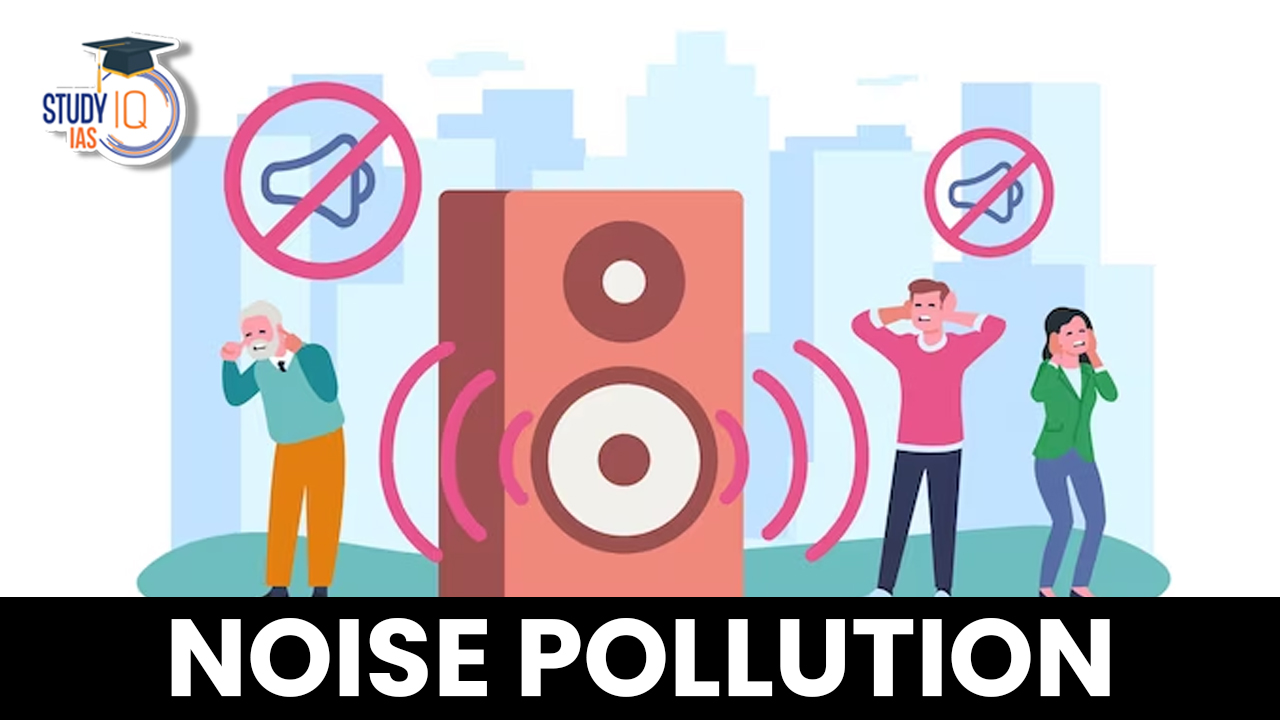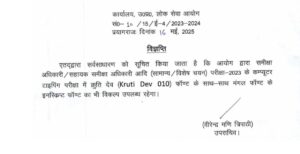Table of Contents
Noise Pollution
Noise pollution is any unwanted or grating sound that has an effect on the health and wellbeing of people and other living things. Over 6% of Indians, according to a WHO estimate from 2007, have hearing loss. Long-term exposure to noise levels above 60 decibels (NIHL) results in noise-induced hearing loss (NIHL). Some of the significant health effects include deafness, cardiac problems, sleep disturbances, and cognitive impairment in young people.
Designing quieter machinery, utilizing acoustic enclosures and vibration isolators, extending the transmission distance, using noise-canceling headphones and earplugs, and other methods can all help reduce noise pollution. You will learn about noise pollution in this article, which will aid you while you study the environmental topics for the UPSC Syllabus.
What is Noise Pollution?
The term “noise pollution” refers to the regular exposure to loud noises that have the potential to harm people or other living things. Noise is defined as an unwelcome sound in accordance with the Central Pollution Control Board’s regulations.
The WHO estimates that 1.1 billion young people (aged 12 to 35) are at risk of hearing loss as a result of noise exposure. In Europe, prolonged exposure to environmental noise is a factor in 12,000 early deaths per year.
Causes of noise pollution
The causes of noise pollution have been mentioned below:
Industrialization
Nowadays, one of the main sources of noise pollution is the expansion of companies in metropolitan areas, which use a variety of noisy machines.
Improper Planning of Urban Areas
Because of crowded housing, limited space, inadequate parking facilities, and frequent battles over essential services that disturb the environment of society, improper and bad urban planning plays a significant role in the creation of noise pollution, particularly in developing nations.
Social Events
- One of the causes of noise pollution is an increase in the number of vehicles on the road.
- Traffic congestion, subterranean trains, airplanes, and other loud noises, for instance, can cause hearing loss.
Vehicles and transportation
The increase in the number of automobiles on the road is one of the causes of noise pollution. For instance, hearing loss may result from excessive noise from airplanes, underground trains, traffic, and other sources. At least 20% of people in the European Union are currently exposed to levels of road traffic noise that are deemed harmful, according to the Frontiers Report.
Construction Sites
Noise pollution is considerably exacerbated by a variety of construction operations, such as mining and the building of bridges, dams, and other structures.
Agriculture
Most farmers are unaware of the detrimental health effects caused by louder noises made by agricultural equipment like tractors, trolleys, and harvesters.
Effects of noise pollution
The World Health Organization (WHO) estimates that 1.1 billion young people (aged 12 to 35) are at risk of hearing loss as a result of noise exposure, and there is sufficient data to support the claim that noise exposure at night results in self-reported sleep disturbance, which is regarded as a health issue. The following are a few effects of noise pollution:
- Hearing Impairment: Prolonged exposure to loud noises that are louder than the average level of sound intensity can cause eardrum damage and hearing impairment.
- Sleeping problems: Noise pollution can interfere with a person’s sleep cycle, which can lead to exhaustion, poor energy, and sleeping disorders.
- Chronic Health Problems: Exposure to noise pollution increases the risk of metabolic and cardiovascular diseases such diabetes, coronary heart disease, high blood pressure, and arterial hypertension. A conservative estimate states that long-term environmental noise exposure contributes to 12,000 premature deaths and 48,000 new cases of ischemic heart disease per year in Europe.
- Traffic noise and other urban noises have a negative impact on other species and endanger their survival. For example, animals use auditory signals to communicate for a variety of reasons, including defending their territory, warning of danger, luring or attracting partners, and rearing their young. However, these functions are significantly hampered by noise pollution.
- Productivity Loss: Working in situations that are too noisy makes people very uncomfortable, which is bad for their mental health and reduces productivity. In turn, this boosts the price of production.
- Noise can also harm non-living creatures, thus it is important to consider this. There have been many cases where loud booms have caused modern, even brand-new buildings to break.
- Human performance: Distractions at work will have an effect on how well people perform.
- Effect on vegetation: It is now well known that humans and plants have many characteristics. They have the same sensitivities as people. A peaceful and cold environment is required for their better development. Noise pollution causes crops with low quality to suffer in a pleasant setting.
- Abortion: During pregnancy, a calm, cool atmosphere should rule. Unpleasant sounds make a woman irritable worse. A loud noise can induce abortion in females.
Steps to Control Noise Pollution
- Green cover expansion ought to be given first attention. Vegetation in metropolitan areas can reduce noise amplification from roads, diffuse noise, and absorb acoustic energy. Additionally, they help to improve natural noises by attracting urban wildlife. This calls for measures like the installation of “green roofs” and tree belts.
- Route interventions are engineering methods that build a wall to block the flow of noise from the source to the receiver. When constructed from recycled materials like plastic and auto tires, both traditional and contemporary materials have showed potential. For instance, it was found that using fiberglass from scrapped wind turbine blades, a barrier effect might reduce road noise levels by 6-7 dB.
- Through the use of integrated solutions, noise pollution should be considered in the context of a wider range of environmental issues, particularly when it is coupled with air pollution. After integration, the findings of several of the countries assessed for the European Environment Agency study improved.
- A 20-foot-wide plantation inside the property isolates the house from the noise of moving vehicles.
- Putting in place acoustic zoning, which involves dividing populous areas from noise-producing areas like airports, train stations, and other industrial facilities. Silence zones should be established in hospitals, schools, and essential offices.
- Safety gear like cotton plugs or ear muffs should be provided to employees working on noisy projects.
- Noise pollution from air traffic can be reduced with the right insulation and noise introduction.
- Airport takeoff and landing regulations.
- Power tool use at night, loud music, land movers, loudspeaker use at public events, etc., should all be forbidden. It is forbidden to utilize appliances—such as horns, sirens, and refrigerators—excessively. Avoid using too many noisy, air-polluting firecrackers.
- By planting a lot of trees to create buffer zones that are covered in flora and absorb noise.
- It’s important to keep musical instrument noise within appropriate limits.
Noise Pollution (Regulation and Control) Rules, 2000
The Noise Pollution (Regulation and Control) Rules, 2000 govern each type of noise pollution. Prior to this, noise pollution and its causes were addressed by the Air (Prevention and Control of Pollution) Act of 1981.
- On February 14, 2000, the Union Government passed the Noise Pollution (Regulation and Control) Rules, 2000 in an effort to reduce the increasing ambient noise level coming from diverse sources in public areas. According to the authority granted to it by the Environment (Protection) Act of 1986, this was done.
- As stated in Rule 5 of the Noise Rules 2000, the use of loudspeakers and public address systems is restricted.
- Rule 5 was altered in 2010 to forbid the use of sound-producing equipment. Before using this technology in any of these situations, written consent is necessary.
- The District Magistrate, Police Commissioner, and any other person not below the level of Deputy Superintendent of Police are designated as the Noise Rules, 2000’s implementing authorities.
- The State Government has the power to permit the use of loudspeakers on or during any annual religious or cultural celebration with a maximum duration of fifteen days. The hours between 10:00 p.m. and 12:00 a.m. are not suitable for such recreation.
| Area Code | Category of area/zone | Limits in DB (Day) | Limits in DB (Night) |
| A | Industrial Area | 75 | 70 |
| B | Commercial Area | 65 | 55 |
| C | Residential Area | 55 | 45 |
| D | Silence Zone | 50 | 40 |


 UPPSC RO ARO Exam Date 2025 Out: Typing ...
UPPSC RO ARO Exam Date 2025 Out: Typing ...
 Maharashtra Bill to Curb Urban Naxalism,...
Maharashtra Bill to Curb Urban Naxalism,...
 International Maize and Wheat Improvemen...
International Maize and Wheat Improvemen...





















